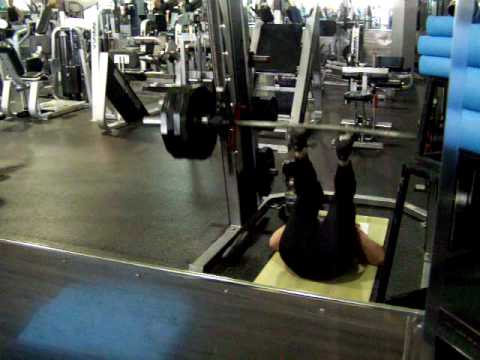As I was writing my Monday post on how to do a pre-lifting warm-up series, it got me thinking of something that happened to me that deserves sharing on SAPTstrength.
First, let me preface the story by saying that, like many of you, I've seen a LOT of shenanigans in commercial gyms. I'm used to observing people bicep curling in the squat rack, trainers taking overweight clients through circuits on BOSU balls, bros doing "chest/shoulders/triceps" on the same day, boys deadlifting with rounded backs, and (loaded) leg press platforms slamming down on an athlete because his trainer didn't show him how to properly place his feet (not kidding).

Essentially, a myriad circus acts that make me want to pour nuclear waste down my throat in order to end my misery.
The majority of you readers have already taken the Red Pill and are now "enlightened" in the realm of strength (or, as Morpheus would put it, you've stayed in Wonderland to see how deep the rabbit-hole goes), and most of the aforementioned ridiculousness has been derided on the internet before, so I'm not standing here to continue ranting about this stuff.
However, something recently happened to me that I felt deserved some attention. A little something related to that whole, warm-up "thing." I realize the concept I'm about to address may be old news to you, but for those of you who hearing this for the first time: Listen up.
So, I'm in the gym the other day (the only one in there actually...this particular commercial facility is quite small), minding my own business and doing some foam rolling. As usual, I stick my headphones in my ears, put my horse blinders on, and keep to myself. As I continue through the foam roll series, a young man, probably in his late-twenties, walks in the door, and heads straight over to the bench press.
No big deal. I've seen this a thousand times, and I'm done with making fun of people heading straight to the bench on a Monday without warming up because they're "ignorant," "non-functional" (whatever that means anymore), or whatever views I once held as an elitist snob upon first entering the fitness industry. **If they're in the gym, getting after it, then who cares, right?
As he circles the bench like a famished lion eying fresh meat, he is bobbing up and down a bit, saying something about how excited he is to test his bench max since he hasn't pressed in a while.
All is well and good, until I perform one more pass over my IT band, and look over to see this man has loaded 295lbs on the barbell! Without doing a single warm-up rep.
I have to blink twice to make sure I'm not imagining anything.
Now, correct me if I'm wrong, but if the world's best bench pressers can do some warm-up reps with the bar only, and then do more warm-up reps with 135lbs, then this man (who I am POSITIVE is not a world-class bencher) can do some freaking warm-up reps, am I right?! I mean, it's one thing to avoid "correcting" someone outside SAPT because their training methodology is different than mine, but it's another to watch someone puncture their esophagus without doing anything to help.

I make my way over to him, and the conversation goes like this (I'm not fabricating this at all, mind you):
Me: Hey there, umm, I couldn't help but notice, but did you just load the bar to 295lbs right after walking in here?
Guy: Yeah man! I'm stoked to test my max today. It's been a while.
Me: Sure...yeah I bet. Well, have you thought about warming up at all? It should help you in your max attempt. (I figured that lecturing him on the inner workings of the central nervous system wasn't going to go over too well).
Guy: Nah. I don't want to waste all my muscle on any sets before the max. Gotta have it all for the max, you know!!
Me: Well, yes, but...
Guy (interrupting me, eyes widening and and finger pointing and waving at me): You know what?! You're just like that other trainer guy I saw in here! He tried to tell me the same thing a while back. Well y'all are wrong, ya know.
 Me: Yeah, maybe we are.....Well, how about I at least stand here to give you a handoff?
Me: Yeah, maybe we are.....Well, how about I at least stand here to give you a handoff?
Guy: No way man!! In the ring, it's just you to fight for and defend yourself, you know? No one is gonna step in there to help you when you're down. When I'm at home, I bench in my basement all the time without a spotter to teach me to fend for myself.
(As I come to find out, he is a competitive boxer).
Me: Okay, well, call it the strength coach in me, but there is no one else in here and you have put on the bar what I am pretty sure may give you some trouble. Why don't we compromise and you at least do a couple reps with 225lbs first, and work up from there? Just trust me on this one.
Guy (slightly miffed): Whatever, sure. That's fine. *Takes the weight down to 225lbs and griiiinnnds outs 4 reps. Then proceeds to put 275lbs on the bar*
(I give the guy a handoff for the 275lbs attempt, and he doesn't come close to making the lift. Gets stapled.)
Guy (getting up off the bench, looking flustered): Man, I used to bench 350lbs for reps all the time, I don't know what happened.
Me: Yeah, you probably did used to do that....bad day, I guess?
*End of Story
My point in all this is....
Do Your Warm-Ups, For the Love!!!!!!
With the wealth of information out there, I'm consistently shocked to find gym members loading up the bar, only to get stapled by a weight they could have lifted like a champ if they warmed up correctly. Using the example above, this is how the guy should have warmed up (assuming his body actually was prepared to lift 295lbs). It doesn't have to look exactly like I'm about to lay out below, but I hope you get the idea:
Bar x 5-10. Whatever, just groove technique. (not kidding here...many of the world's best lifters start with just the bar)
135x5
185x3
225x2
255x1
275x1
295xEpic Win
Note that a lot of autoregulation goes into play here. For example, say he went for the 275x1 lift but it went up slowwww. It would probably be best to call it a day and come back when he was feeling more fresh. Conversely, say that 275x1 flew up super fast....maybe he could even have gone for a 300lb attempt if he felt "on."
Some days you're going to have it, and other days you won't. Sorry, but that is life. The good news is, a proper warm-up will help you determine what kind of day it is.
**Still fun to talk about sometimes, though.



